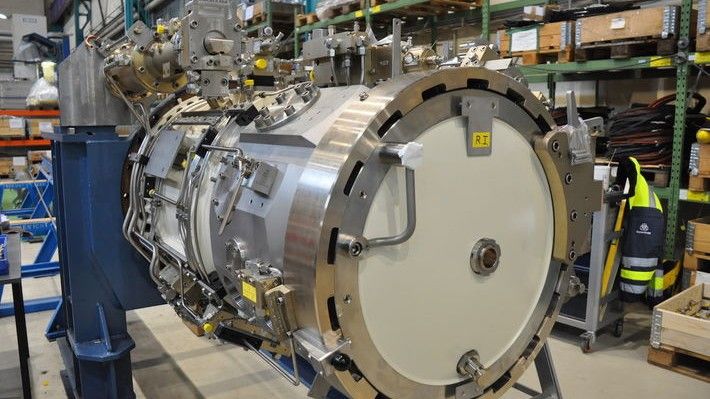Orka – The German Way: Will the Polish Navy Submarines be Built in Szczecin?

Thyssenkrup Marine Systems’ offer for Poland includes delivery of the first submarine in 2027. The building process and overhauls would take place in Szczecin, while maintenance and servicing could be carried out in Gdynia. These are the three cornerstones of the proposal created by the German company which is one of the three entities submitting a bid in the Polish Navy’s Orka submarines procurement programme.
The Germans are proposing that 212CD submarines are procured by the Polish Navy – this type of vessel is a derivative of the Type 212A that is being operated by German and Italian marine services. The competitors include the French Naval Group offering the Scorpène submarines, and Saab, offering the A26. Each and every of the aforesaid offers has its own pros and cons.
This week, a group of Polish journalists has been invited to get acquainted with the TKMS facility in Kiel (formerly known as Howaldtswerke-Deutsche Werft, HDW). The hosts also made an announcement concerning a letter of intent, signed back in December 2017 with the Polish Armaments Group. Should the German offer be selected as the one to become the pillar of the Orka programme, thyssenkrupp Marine Systems is willing to establish a joint venture company with PGZ. The document in question, as tkMS suggests, defines the potential conditions that would be adopted if collaboration is launched.

The German company also would like to transfer the relevant technologies, so that Stettin becomes a place where the most significant overhauls with regards to the submarines could take place. Furthermore, the vessels in question would also be built there. Meanwhile Gdynia would be a base for the ongoing maintenance and periodic and medium-scale repairs concerning the submarines.
tkMS suggests that several arguments would support such course of events. Firstly, Gdynia is the largest of the Polish Navy’s operating bases where a squadron of submarines is stationed. Thus it would be best to have the maintenance capabilities established locally. On the other hand, the “Tri-City” (Gdansk-Gdynia-Sopot) shipbuilding companies compete against themselves in a fight to acquire the best human resources available. Szczecin is far away from any competition. Moreover, tkMS may also see the Szczecin’s closeness to Kiel as an advantage, since the two cities are separated by 4.5 to 5 hours of travel only. Kiel would serve as a training base for the Polish shipbuilders. In total 500 to 700 employees would work at the joint venture formed by tkMS and PGZ, as the Germans declare.

Recovering the capabilities of the shipbuilding industry is one of the objectives of the Strategy of Responsible Development adopted by the current PM/former Minister of Development. Acquisition of the Stettin Shipbuilding facility via the MARS fund in the early 2017 was one of the elements of the aforesaid strategy. This was followed by the government declaring its will to create the largest shipbuilding group located at the Baltic shore. Antoni Macierewicz, who was the acting head of the Polish Ministry of Defence at the time, was mentioning the fact that submarines would be expected to be built in Poland.
Even though the representatives of the tkMS company remain silent within that regard, one should add that Stettin enjoys a greater political support, in comparison with Tricity. The Western Pomeranian region is from where two of the Law and Justice leaders come. It is difficult to expect that the above fact will not be taken into the equation: both by the Polish authorities, as well as by the bidders who are competing to sign the Orka contract.
The delivery of the first submarine “made in Poland”, as tkMS seems to suggest, would be possible in 2027. This could happen on condition that the Polish Ministry of Defence selects the supplier now. Is this even possible? On one hand the Ministry announced in late January 2017 that the partner for the Orka programme would be selected in that month. One should remember though that the Polish Ministry of Defence has undergone a major leadership transformation, with the head of the Ministry, Antoni Macierewicz being replaced by Mariusz Błaszczak. Meanwhile, the technical modernization of the Armed Forces has been placed in the hands of Sebastian Chwałek who is the successor to Bartosz Kownacki. It is plausible that the newly appointed officials would need time to get themselves up to speed with regards to the most important of the arms procurement programmes and with the issues extended beyond that scope.
Neither declarations made by tkMS, nor similar statements made by any other bidder, concerning the potential building of submarines in Poland, would mean that each and every element of the submarine would be created domestically. For instance, the Germans suggest that the pressure hull building capability could not be possibly established in Poland, in a cost-effective manner. The reason for this stems from the high cost of the transfer of technology and founding the industrial capabilities, even in case when the Polish facilities are included in the future supply chain of the tkMS company, as the entity promises building of submarines for export purposes too. The pressure hulls though would still be built at the facility in Kiel. However, integration of the pressure hull sections, and integration of the whole submarine into a single body would be taking place in Poland.

One of the key requirements defined by the Polish Ministry of Defence for the Orka programme was (at least until recently) to have the future submarines equipped with a set of long range cruise missiles. And here the French offer is advantageous, since it readily includes a package consisting of submarines and SCALP Naval missiles, whereas German and Swedish vessels would have to be integrated with some relevant missiles. However, in practical terms, only Tomahawks could be considered as a viable option here.
The representatives of the tkMS company place a great emphasis on the company’s experience gathered in the area of integrating a variety of effectors with German-made submarines’ torpedo tubes. The company suggests that such armament was being usually delivered by the Ordering Party, as this kind of assets may usually be only acquired via intergovernmental contracts. The German bidder claims that Poland stands a chance of acquiring missiles independently in the US, since Warsaw was the first foreign customer to sign an agreement concerning the AGM-158B JASSM-ER missiles which are going to be integrated with the Polish Air Force’s F-16 C/D Block 52+ jets.
However, before the new generation submarines are received, a proper training would be required for the Polish submarine crews. This renders a need to procure a training platform. This stems from the fact that Kobben-class submarines are being decommissioned (ORP Kondor has been withdrawn in December 2017, while another submarine is expected to be decommissioned during the first half of 2018). Bridge solutions are offered by each of the three potential bidders involved in the Orka programme.
Each of the three bidders proposes original, proprietary solution here. The German government proposed that it would share one of the 212A submarines, currently operated by the Deutsche Marine, with the Polish Navy.
The details pertaining to that offer were not covered in Kiel, as the representatives of the German government did not attend the meeting. However, officers working at the Eckernförde base near Kiel, tasked with training the future crews, did attend the event. Eckernförde is also a home for the 1 Ubootgeschwader, a unit gathering all of the German submarines. The aforesaid training centre is already working closely together with the Polish Navy - one of the technicians and one operational officer have gone through a training course at the said facility. Further Polish sailors are either attending or getting ready to participate in the course.
According to the representatives of the German Navy’s training facility in Eckernförde, organizing training for the submarine crews with previous experience gathered on a submarine of different class than the 212A would take 18 months. It shall also be taken into account that further training would be required to render the crews able to board the 212CD submarines. Full operational training, including joint training courses, would take up to 3-4 years.
212CD is the designation for the future German and Norwegian submarine specification. CD refers to common design. At the beginning of 2017 Oslo decided to build the submarines jointly with Berlin. French offer had been considered by Norway previously.
There is a scarcity of information available on the 212CD submarines. Even the dimensions remain confidential. The vessel is going to be derived from the 212A submarines. As the representatives of the shipyard admit, the new vessel will be fitted with two MTU diesels, while the older ones use a single set as such. The project was being developed as a successor to the older 212A type, hence its original 212NG designation, later changed into 212CD, following the Norwegian decision to work together with the German manufacturer.


